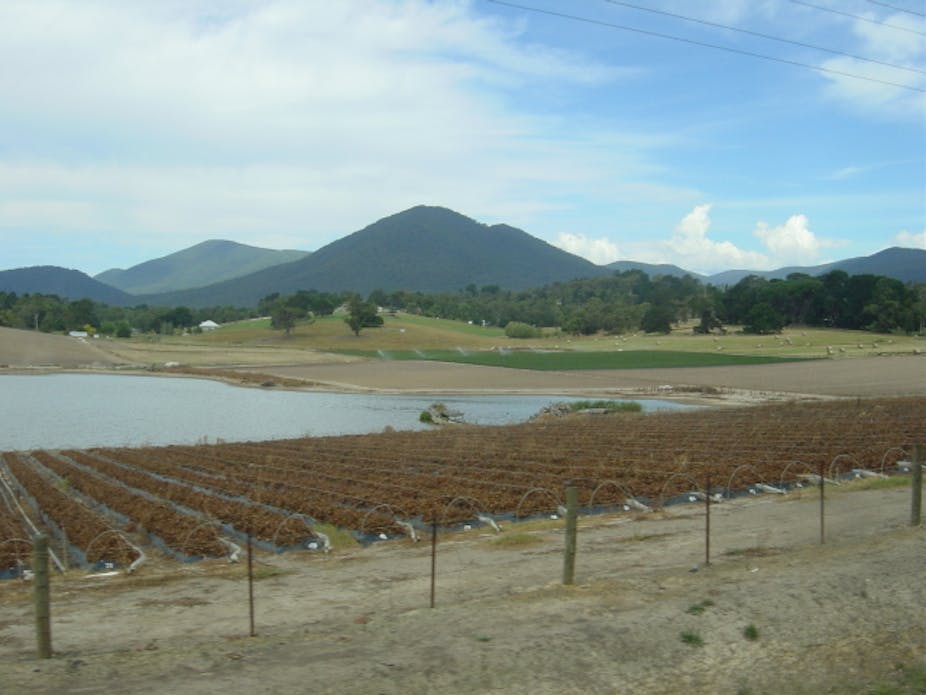The Victorian Planning Minister, Matthew Guy, recently announced an urban expansion for Melbourne: 5,958 hectares of new suburbs and transport corridors. But he didn’t mention the implicit costs of changing land use; in particular, he didn’t discuss where Melbourne will get its fresh food.
This is a concern if the government assumes that population growth can be accommodated as it has in the past, by developers speculating on adjacent farm land to create new low-density “affordable” suburban housing estates, dependent on cars for access to services. Often, this process ignores the forest for the trees - loss of fresh food production from the peri-urban region in a death by a thousand cuts.
Indeed, as Larsen suggests in citing Simms: Nothing reveals the thin veneer of civilisation like a threat to its food or fuel supply, or the cracks in society like a major climate-related disaster. A cocktail of all three will give cold sweats to the most hardened emergency planner.
Planning for food is not explicitly included in the Victorian Planning and Environment Act (1987) or the new State Planning Policy Framework (introduced on 21 September 2010, Amendment VC 71).
One of the areas most affected by a shift from agriculture to housing will be the City of Casey. Councillor Stapledon from Casey Council recently said the Bunyip food belt (an area in the southeast of Melbourne which stretches across four municipalities), must be protected from housing developments. This area supports 2,000 local jobs and generates in the vicinity of $400 million of food production.
According to the Casey Weekly, in 2007, 7% of Casey [Shire] residents - about 16,000 households - were “food insecure”, defined as not having access to enough food for an active, healthy life. This figure is above the state average of 6%. A VAMPIRE (vulnerability assessment for mortgage, petroleum and inflation risks and expenses) index shows a significant number of working families in Casey are at high risk of experiencing the health impacts of chronic food insecurity over the next decade.
The process of “consultation” for this State Planning Policy Framework rode roughshod over food-producing councils like Casey: Delivering Melbourne’s Newest Sustainable Communities does not consider the issue of food security for Melbourne nor the loss of gross agriculture industry worth approximately $20-30million pa and 550 direct jobs in Casey. So, does this announcement mean that Melbourne residents are at increased risk of going hungry or paying more for fresh food?
Short answer – no.
In stark contrast to Sydney’s situation, I suggest there are two main reasons why Melbourne is much better placed for coping with the sometimes unintended consequences of urban expansion.
First, the Victorian Government has opened its ears to considerations of food security. VicHealth has championed fresh food production and access in the outer urban areas as a high priority in planning. Some 80% of the 79 local councils in Victoria have Municipal Public Health Plans as prescribed under the Public Health and Wellbeing Act 2008 (which superseded the Health Act 1958). Fresh food is regarded as an integral pillar of such local government plans for community health and well-being.
VicHealth and Deakin University have also set up the Food Alliance, an organisation that investigates and makes evidence-based recommendations to government on the food system for Victorians.
The Victorian Liberal Nationals coalition created a policy portfolio under the Minister for Agriculture and Food Security. There is, therefore, the purposeful addition of food production to the planning considerations of local councils in Melbourne and the state government. This situation makes for a more sophisticated, systemic analysis and practice of planning urban expansion in response to population growth, beyond the immediate, ultimately flawed, economic framework.
Second, the planning process has responded to these concerns. In 2010, the Victorian Parliament expanded planning beyond considering just the economic framework, when it went through an Outer Suburban/Interface Services and Development Committee and Inquiry, and settled on the principles for setting Melbourne’s Urban Growth Boundary. The outcomes of the Inquiry are reflected in the Minster’s recent announcement of land to be released for housing in the “interface municipalities” of Cardinia, Casey, Hume, Melton, Mornington Peninsula, Nillumbik, Whittlesea, Wyndham and Yarra Ranges.
Planning processes covering a wider range of factors – bio-physical, social and economic - were scrutinised for a specific cartographical/geographical sub-set of the city of Melbourne. The economics of real estate development are not sufficiently sophisticated to deliver optimum outcomes for new communities at a variety of interconnected scales. Including food in the planning equation brings in the need to plan for local jobs, water use, transportation and fuel costs, and social disadvantage such as going hungry or having a poor diet.
The implication is that the Victorian State Government has led a planning initiative focussing on two things: the local jobs, personal networks, community values and distribution of fresh food to people in the vicinity of production; and, the importance of fresh food supply for all of Melbourne’s residents, into the future.
That is, in order to protect the future access for all Melbourne residents to the immediate and cascading benefits of fresh food, planning had to occur at a local, distributed level in order for these benefits to be accomplished. Add to that the realisation that population growth is a key long term driver more important than short term economic cycles in planning and the Victorian State Government is developing a more robust or resilient path to at least minimise hunger and malnutrition and cope with inevitable population growth out to 2050. It’s certainly a path more robust, systemic and sophisticated than the problematic path for Sydney.

